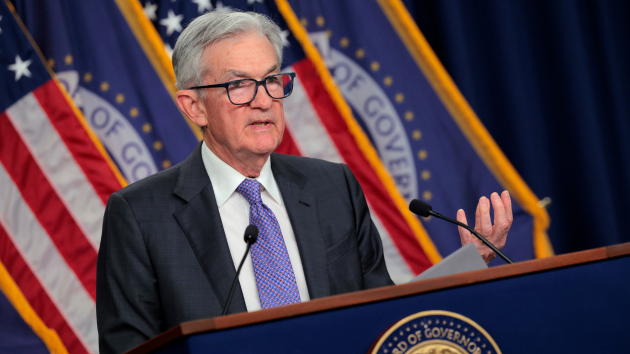Skyrocketing child care costs show how inflation could impact 2024 election
Written by ABC Audio ALL RIGHTS RESERVED on June 6, 2024

(NEW YORK) — Jessica Morrison and Jason West, a Philadelphia-area couple with a 4-year-old daughter, stood on the verge of a financial breakthrough.
West was breezing through the hiring process to become a driver at UPS, a job that paid $400 a week and would supplement Jessica’s salary as a state employee.
“It was exciting,” Morrison told ABC News, recounting a moment that took place five years ago. “This was something that could bring us up.”
Their hopes soured, however, when they realized child care would cost them all of the added income, even as the loss of West’s flexible schedule would complicate the family’s daily life. West withdrew his application.
“It was really disheartening,” said West, who has worked gig jobs ever since.
Though their daughter has reached school age, the couple says child care costs have become even less affordable for their 5-year-old son.
As the November election approaches, inflation ranks as a top issue for voters beset by a yearslong surge in the price of essentials like gasoline, flour and housing. But less attention has been paid to the skyrocketing cost of child care, which strains the monthly budget for millions of families.
The affordability crisis in child care threatens not only strapped families but also a vast network of facilities struggling to stay in business as well as the nation’s overall economic strength, which depends on the capacity of parents to work outside the home, experts told ABC News.
Democrats and Republicans in Washington, D.C., differ significantly on the issue, amplifying the stakes of this year’s election, Rachel VanSickle-Ward, a professor of political studies at Pitzer College, told ABC News.
“Based on who wins in November — both at the presidential level and at the congressional level — it is make it or break it for child care policy,” VanSickle-War said.
Families in the U.S. spend an average of $11,000 on child care each year, which amounts to a nearly 250% increase since 1991, the advocacy group Child Care Aware found in 2022.
In recent months, the rise in prices has accelerated. The cost of child care climbed 4.1% over the year ending in April, outpacing the overall inflation rate by more than half a percentage point, U.S. Bureau of Labor Statistics data shows.
Joanne Sawicki Luszczak and her daughter Tiffany Martin, the owners of Teddy Bear College in Bensalem, Pennsylvania, say they have raised the price of tuition in recent years as a means of weathering increased costs of their own.
Teddy Bear College provides snacks and lunch for students each day, leaving its balance sheet vulnerable to the recent rise in food prices.
Meanwhile, the child care center has raised wages for its workers, trying to stem an exodus of entry-level employees who have sought better pay elsewhere. While pay has increased for workers the past few years, the median weekly wage in child care is $635, or about $33,000 a year, Axios reported in April.
“The challenge of actually retaining good quality staff is tricky, because what the tuition brings in is what we have to pay,” Sawicki Luszczak said. “If we raise tuition, we can give raises out. Well, there’s a limit to that.”
The squeeze faced by families and child care centers has elicited policy proposals at the state and federal level.
In Pennsylvania, a key swing state, a bipartisan measure last year expanded the state’s child tax credit.
Eligible families — those earning less than $43,000 a year with two or more children — receive a state tax credit of $2,100, delivering a 100% match to the federal tax credit. Families above the income threshold receive a tax credit of $1,200.
Democratic Rep. Tina Davis, a sponsor of the law, said it will lower the cost barrier for families and, in turn, help boost income at day care centers and other businesses.
“It just puts money in people’s pockets,” Davis said. “When you put money in people’s pockets, they’re going to spend it. It’s going to help small businesses.”
Republican Rep. Joe Hogan, who also backed the measure, said its benefits will extend economy-wide as it allows some parents to remain at their job or enjoy the latitude to pursue a new one.
“No party has a monopoly on good ideas,” Hogan said. “We’ve got to be putting families first. We need more policies so that people feel comfortable entering the workforce.”
Bipartisan agreement has proven elusive at the federal level, however. Congress has failed to renew a pandemic-era expansion of the federal child tax credit that expired in 2022.
President Joe Biden and former President Donald Trump offer dramatically different approaches to the issue, said VanSickle-Ward, of Pitzer College.
Biden has sought a role for the federal government to spend on making child care more affordable, she added. Child care subsidies were included in Build Back Better, a 2021 spending package backed by Biden that failed to garner sufficient support in Congress.
In his state of the union address, in March, Biden proposed a minimum tax for billionaires that would help fund federal support for families seeking child care.
“Imagine a future with affordable child care so millions of families can get the care they need and still go to work and help grow the economy,” Biden said.
In a statement to ABC News, the Biden campaign contrasted the policies taken up by the two major candidates.
“Donald Trump has no plan to help lower the costs of child care, in fact, his agenda raises costs on the typical American family by at least $1,700 annually, cuts Social Security and Medicare, and repeals the Affordable Care Act. President Biden knows that affordable child care lifts our economy, which is why he’s fighting everyday to lower costs and give families more breathing room,” Biden campaign spokesperson Seth Schuster said.
For his part, Trump proposed a $1,200 tax credit for child care during his 2016 campaign. A year later, Trump enacted his signature tax measure, which expanded the child tax credit from $1,000 to $2,000 per child. The expanded child tax credit was unavailable to more than 25 million low-income families, however, according to an analysis by the nonpartisan Center on Budget and Policy Priorities.
“I haven’t heard as much from Trump on childcare in this election cycle,” VanSickle-Ward said.
In a statement to ABC News, the Trump campaign touted his record on child care and faulted Biden for the price spike.
“President Trump doubled the Child Tax Credit, expanded access to quality, affordable childcare, and created the first paid family leave tax credit for job creators — easing the burden on hardworking parents and families,” said Karoline Leavitt, national press secretary for the Trump campaign. “Due to Joe Biden’s out-of-control spending, prices are up, real wages are down, and it’s harder than ever for families to make ends meet.”
“By making life affordable again and empowering parents, President Trump will ease the burden of Bidenflation, improve academic excellence for students, and strengthen our childcare system for all American families,” Leavitt added.
Regardless of what happens in November, the affordability of child care will hold major implications for the U.S. going forward, VanSickle-Ward said.
“It’s really impossible to overstate how impactful child care is to the economy,” VanSickle-Ward said.
Copyright © 2024, ABC Audio. All rights reserved.

 KVSP
KVSP 




